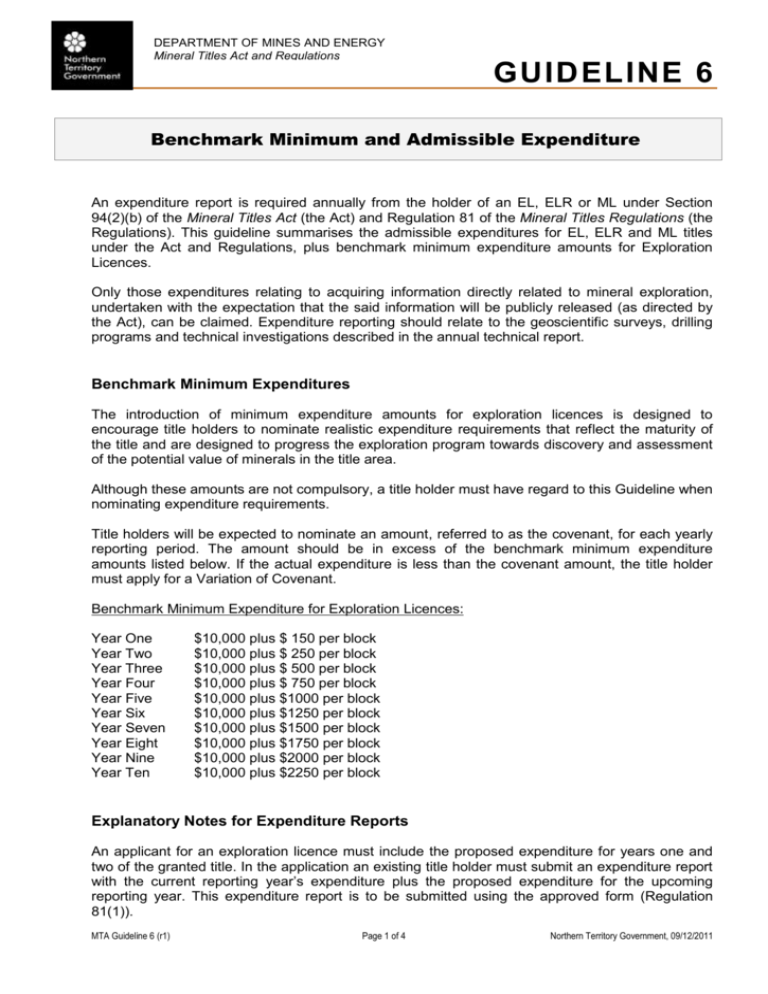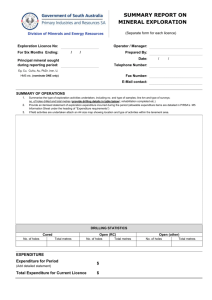Guideline 6: Benchmark Minimum and Admissible Expenditure
advertisement

DEPARTMENT OF MINES AND ENERGY Mineral Titles Act and Regulations GUIDELINE 6 Benchmark Minimum and Admissible Expenditure An expenditure report is required annually from the holder of an EL, ELR or ML under Section 94(2)(b) of the Mineral Titles Act (the Act) and Regulation 81 of the Mineral Titles Regulations (the Regulations). This guideline summarises the admissible expenditures for EL, ELR and ML titles under the Act and Regulations, plus benchmark minimum expenditure amounts for Exploration Licences. Only those expenditures relating to acquiring information directly related to mineral exploration, undertaken with the expectation that the said information will be publicly released (as directed by the Act), can be claimed. Expenditure reporting should relate to the geoscientific surveys, drilling programs and technical investigations described in the annual technical report. Benchmark Minimum Expenditures The introduction of minimum expenditure amounts for exploration licences is designed to encourage title holders to nominate realistic expenditure requirements that reflect the maturity of the title and are designed to progress the exploration program towards discovery and assessment of the potential value of minerals in the title area. Although these amounts are not compulsory, a title holder must have regard to this Guideline when nominating expenditure requirements. Title holders will be expected to nominate an amount, referred to as the covenant, for each yearly reporting period. The amount should be in excess of the benchmark minimum expenditure amounts listed below. If the actual expenditure is less than the covenant amount, the title holder must apply for a Variation of Covenant. Benchmark Minimum Expenditure for Exploration Licences: Year One Year Two Year Three Year Four Year Five Year Six Year Seven Year Eight Year Nine Year Ten $10,000 plus $ 150 per block $10,000 plus $ 250 per block $10,000 plus $ 500 per block $10,000 plus $ 750 per block $10,000 plus $1000 per block $10,000 plus $1250 per block $10,000 plus $1500 per block $10,000 plus $1750 per block $10,000 plus $2000 per block $10,000 plus $2250 per block Explanatory Notes for Expenditure Reports An applicant for an exploration licence must include the proposed expenditure for years one and two of the granted title. In the application an existing title holder must submit an expenditure report with the current reporting year’s expenditure plus the proposed expenditure for the upcoming reporting year. This expenditure report is to be submitted using the approved form (Regulation 81(1)). MTA Guideline 6 (r1) Page 1 of 4 Northern Territory Government, 09/12/2011 An expenditure report is only required with an Annual report. Upon partial relinquishment of an exploration licence expenditure is not required. Upon final surrender, it is necessary to specify that the report is an “Annual and Final” and provide an accompanying expenditure report. The intention of the Mineral Exploration and Mining Expenditure Reporting form is to capture those costs directly attributable to each title for the acquisition and interpretation of new exploration data. A description of the work undertaken for each Admissible Expenditure category (where appropriate), must be stated, together with the total amount spent on those activities. Details of requirements for submission of the form, including formats and lodgement details are provided in Guideline 7 - Reporting on Mineral Titles. Admissible Expenditure The following categories list activities that may be claimed against expenditure commitments. An example of the type of information required is provided. If a section of admissible expenditure is not relevant to your operations, insert “not applicable” at the appropriate section of the approved form. Expenditure relating to data acquisition (by any method) can only be claimed if the data is supplied to the Department in the format advised in Guideline 7 - Guidelines for Reporting on Mineral Titles. A. Geological Activities and Prospecting Geological mapping, core logging, geological sample description, petrology, geological data processing, basic interpretation and expenses associated with conducting these activities on the mineral title. General prospecting including metal detecting, loaming, panning, sampling, dollying and dryblowing. Specify and quantify all activities undertaken, eg. hours spent mapping on the title; or, 300 metres of diamond core logged and cross-sections prepared; or, 15 samples prepared for petrology and analysed in-house. Include only salaries and wages directly related to ‘on ground’ tasks. Conceptual targeting or desktop studies are to be included in Office Studies and Overheads category. B. Geochemical Activities Geochemical sampling, analysis of surface and subsurface geochemical samples, handheld XRF assays, PIMA or hyperspectral studies on rock samples, mineral separation, mineralogy and analysis of diamond indicator minerals or other minerals, geochemical data processing and interpretation, isotopic studies, age dating and metallurgical testing. Specify the number of samples collected and/or assayed, eg. 205 rock chip samples were collected and after testing with handheld XRF, 180 were sent for analysis by AAS. C. Geophysical and Remote Sensing Activities Ground geophysical surveys, scintillometer surveys, track etch surveys, downhole logging, geophysical data processing and interpretation. MTA Guideline 6 (r1) Page 2 of 4 Northern Territory Government, 09/12/2011 Airborne geophysical activities including aerial hyperspectral surveys, aerial survey costs, geophysical data processing and interpretation. Includes hire of specific vehicle/plane/helicopter and running costs for the actual survey. Purchase or acquisition and interpretation of remotely sensed data, satellite imagery, aerial photographs. Specify and quantify the number of data points, grid spacing or flight line kilometres, orientation, height; eg. Spot imagery was purchased and registered; or, 450 line km of magnetics and radiometrics was flown at 1 km line spacing, in NNW direction and 50 m altitude. D. Drilling All forms of drilling except pre-blast drilling, including exploration and grade-control drilling, underground, water bores, pre-collars, sterilisation, drill pad access tracks, drill site preparation, gridding. Specify the type of drilling, metres drilled and number of holes. If non-exploration drilling, specify type (eg. sterilisation, water bores). Specify number of metres gridded or number of drill pads prepared. Eg. 12 RAB holes were drilled for a total of 600 m and 5 km of gridding and 12 drill pads were prepared. E. Bulk Sampling and Earth Works Plant and equipment hire, fuel and consumables used under this title for costeaning, trenching and bulk sampling. Include all other substantial earthwork expenses. Specify the tonnes excavated or moved, or length and depth of trenches. Eg. 100 m trenched to a depth of 1 metre. Note: sampling costs and analysis of those samples taken from trenches or costeans should be reported under category C. Geochemical Activities. F. Rehabilitation Rehabilitation costs of drill holes, drill pads, grid lines, trenches. Specify the number of holes, length of tracks and how they were rehabilitated. Eg. 18 drill holes were plugged and drill pads ripped by a grader; or, 50 km of grid lines were ripped by a grader and previously collected top soil redistributed. G. Pre-feasibility including Metallurgical and Environmental Feasibility and pre-feasibility studies, environmental studies, mine planning, engineering and design studies, if supplied to the Department and able to be publicly released within 5 years (any Corporate-in-Confidence material must not be supplied and cannot be claimed). H. Office Studies Non-field geoscientific studies such as research, literature and desktop studies, report preparation, map production, planning of exploration programs and conceptual targeting studies. MTA Guideline 6 (r1) Page 3 of 4 Northern Territory Government, 09/12/2011 I. Overheads (to a maximum of 15% of the total of A to H above) Administrative activities, such as office costs. Field supplies and support - general exploration equipment not specific to a given survey, consumables, plant and equipment hire/fuel/oil of general use vehicles - for geologists or field staff used on this title, depreciation of direct exploration equipment if used on this title. Field camp activities - establishment and maintenance of exploration base camps, food and accommodation, camp costs for contractors not directly associated with mineral exploration activities conducted on the mineral title. Travel and accommodation: only those costs directly associated with mineral exploration activities conducted on the mineral title, excludes marketing and road shows. J. Preliminary Airborne Exploration Regulation 81(3) states that “for the first operational year of an EL the title holder may also include in the expenditure report details of any amount, as specified in an airborne survey report, expended by the title holder on an approved airborne survey of land now in the title area of the EL”. Non Admissible Expenditure (ie. expenditure that cannot be claimed) Land access negotiations Rent for titles Fines and late lodgement fees Insurance Transfer costs Company Prospectus Title Search Costs of Reporting to a Stock Exchange Bond / Security Deposit Legal costs Marketing (either for the title or the commodity) Costs of Transfers, Dealings or JVs Costs of floating a company Advertising Training not directly related to this title Data capture where the data are not supplied to the Department in the correct format Purchase of data or reports where these are not supplied to the Department in the correct format Tenement management fees Corporate-in-confidence material must not be supplied and cannot be claimed Conferences Salaries and Wages of staff not engaged on activities related to the title Land Access Negotiation Expenditure Although land access negotiation expenditure is not admissible for the purposes of the expenditure condition, title holders are required to report their expenditure in the relevant section of the approved form. Such expenditure would include all land access negotiations (general land access meetings and specific site clearances) and any compensation payment directly related to access. Other useful information includes where and with whom meetings were held, progress made and issue of an AAPA clearance certificate. MTA Guideline 6 (r1) Page 4 of 4 Northern Territory Government, 09/12/2011






